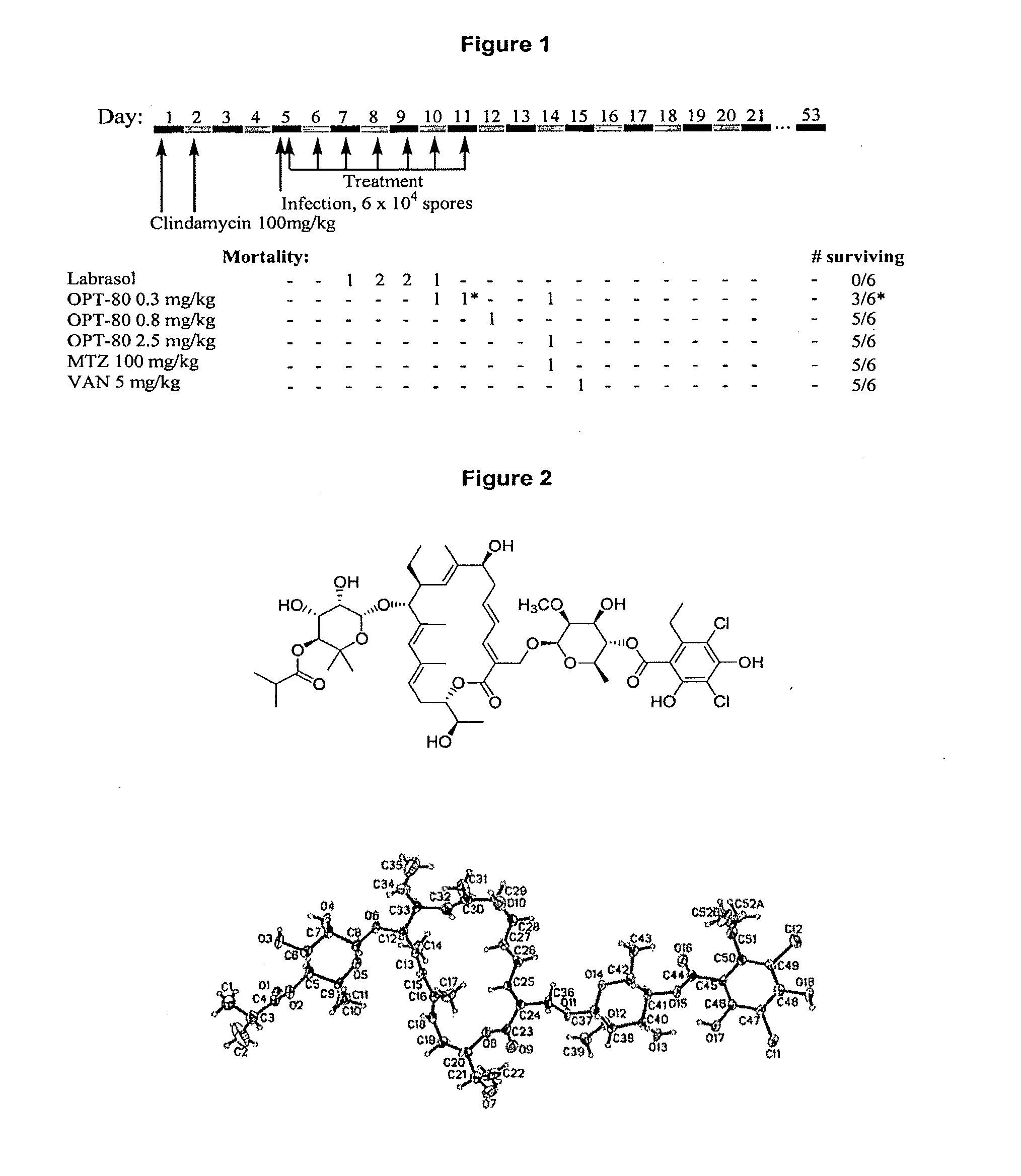Treatment of disease associated with the use of antibiotics
a technology of antibiotics and diseases, applied in the direction of antibacterial agents, extracellular fluid disorders, antibody medical ingredients, etc., can solve the problems of serious systemic infection, major economic burden, and increased health care cost and mortality, so as to prevent release and degradation, prolong the delay of release time, and delay the effect of releas
- Summary
- Abstract
- Description
- Claims
- Application Information
AI Technical Summary
Benefits of technology
Problems solved by technology
Method used
Image
Examples
example 1
[0114]In vitro activity of Compound I against laboratory and clinical strains of bacteria.
[0115]The activity of Compound I was tested against laboratory strains of different species of bacteria using NCCLS antimicrobial susceptibility testing guidelines. Compound I demonstrated excellent activity against Clostridium sp, Micrococcus sp. and moderate activity against Staphylococcus sp. Including MRSA and Enterococcus sp. Including VRE (Table. 2).
TABLE 2Activity of Compound I against laboratory strains from American TypeCulture Collection (ATCC)Gram negativeGram positivebacterianRangebacterianRangeAcinetobacter sp.2 1->32Bacillus sp.21Bacteroides sp.5>32Clostridium sp.4≦0.015-0.0625Campylobacter sp.3 64->64Enterococcus44sp. (incl. VRE)Citrobacter sp.2>64Lactobacillus3 1->32sp.Enterobacteriaceae.10>32Micrococcus4≦0.125sp.Fusobacterium sp.1>32Anaerobic4≦0.06-1 Grampositive cocciHelicobacter sp.1>32Staphylococcus6 1-16sp.(incl. MRSA)Moraxella sp.21-2Streptococcus516-32Neisseria sp.3 8-...
example 2
Comparative Efficacy of Compound I, Metronidazole, and Vancomycin in the Hamster Model of Clostridium difficile Associated Diarrhea
[0118]To evaluate the in vivo efficacy of Compound I in the treatment of Clostridium difficile-associated colitis, Compound I was tested in a hamster model of clindamycin-induced colitis in comparison with both vancomycin and metronidazole. Animals were treated with two oral doses of clindamycin at 100 mg / kg. Three days after the second dose of clindamycin, they were inoculated with toxigenic C. difficile spores. Eight hours after infection the animals received oral Compound I, vancomycin or metronidazole for 7 days. Animals were observed daily for the presence or absence of diarrhea. Necropsies were performed on some animals that died during the experiment, and cecal contents were assayed for C. difficile toxin A. Hamsters were monitored for 20 days, and the cumulative mortality during this period was recorded (FIG. 1). All three tested antibiotics prot...
example 3
Oral Administration of Compound I to Humans
[0119]Tolerability and pharmacokinetics of Compound I following single dose administration was investigated in 16 healthy volunteer subjects. The clinical trial was a single dose, double blinded, randomized, placebo-controlled, dose escalation study.
[0120]Compound I was administered orally after a morning breakfast to volunteer subjects. Plasma, urine, and fecal concentrations of Compound I were determined for pharmacokinetic evaluation.
[0121]After oral administration, little Compound I was detected in the blood; concentrations were near the lower limit of quantitation (LLOQ=5 ng / mL). Only one subject in the 450 mg dose group had plasma concentrations that were detectable as late as 8 hours. The highest plasma level observed was 37.8 ng / mL (in the highest dose, 450 mg group).
[0122]The fecal recovery of unchanged Compound I as a percent dose of administered was about 20% in the 200 and 300 mg dosing groups with the mean values for the corres...
PUM
| Property | Measurement | Unit |
|---|---|---|
| temperature | aaaaa | aaaaa |
| weight | aaaaa | aaaaa |
| pH | aaaaa | aaaaa |
Abstract
Description
Claims
Application Information
 Login to View More
Login to View More - R&D
- Intellectual Property
- Life Sciences
- Materials
- Tech Scout
- Unparalleled Data Quality
- Higher Quality Content
- 60% Fewer Hallucinations
Browse by: Latest US Patents, China's latest patents, Technical Efficacy Thesaurus, Application Domain, Technology Topic, Popular Technical Reports.
© 2025 PatSnap. All rights reserved.Legal|Privacy policy|Modern Slavery Act Transparency Statement|Sitemap|About US| Contact US: help@patsnap.com



